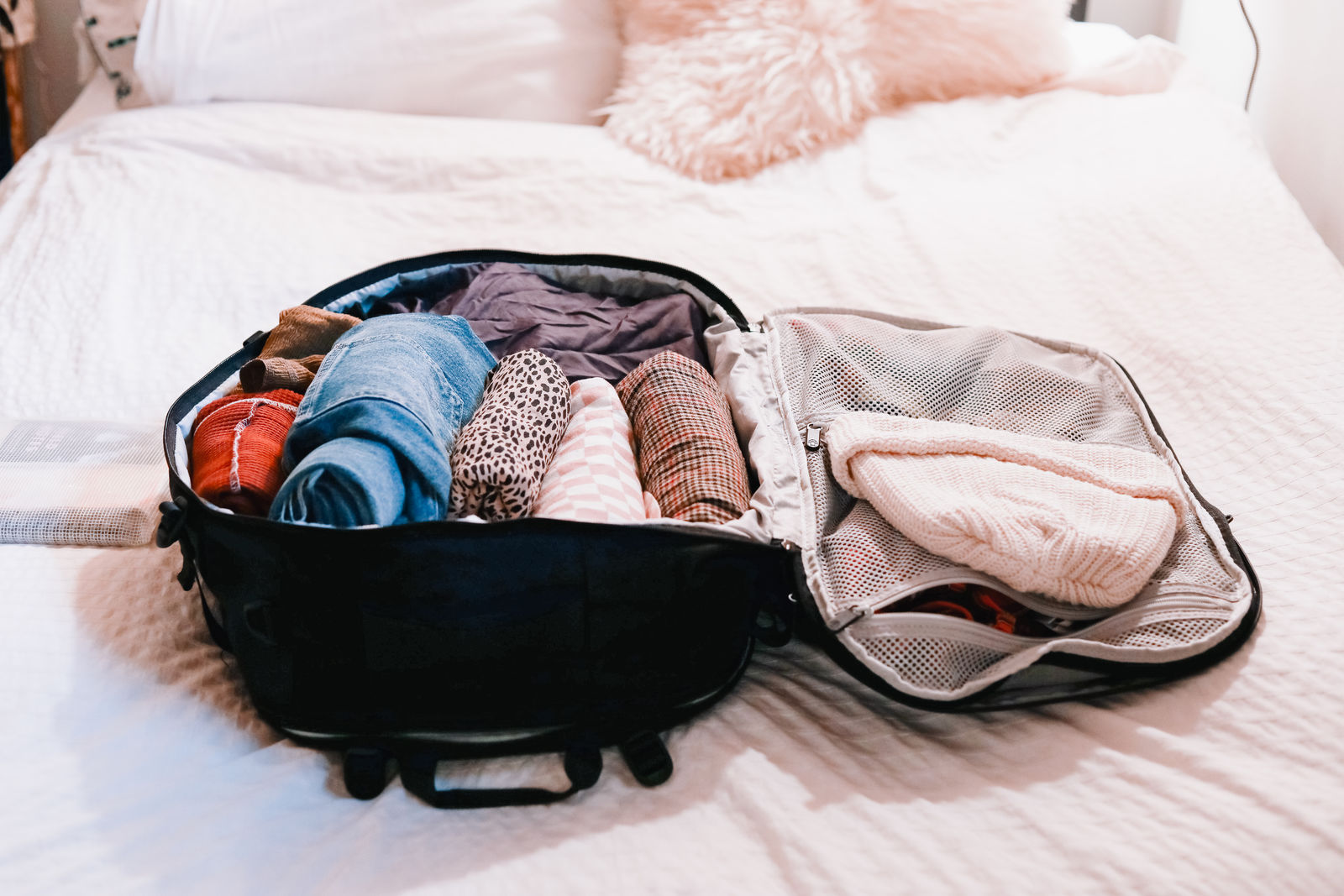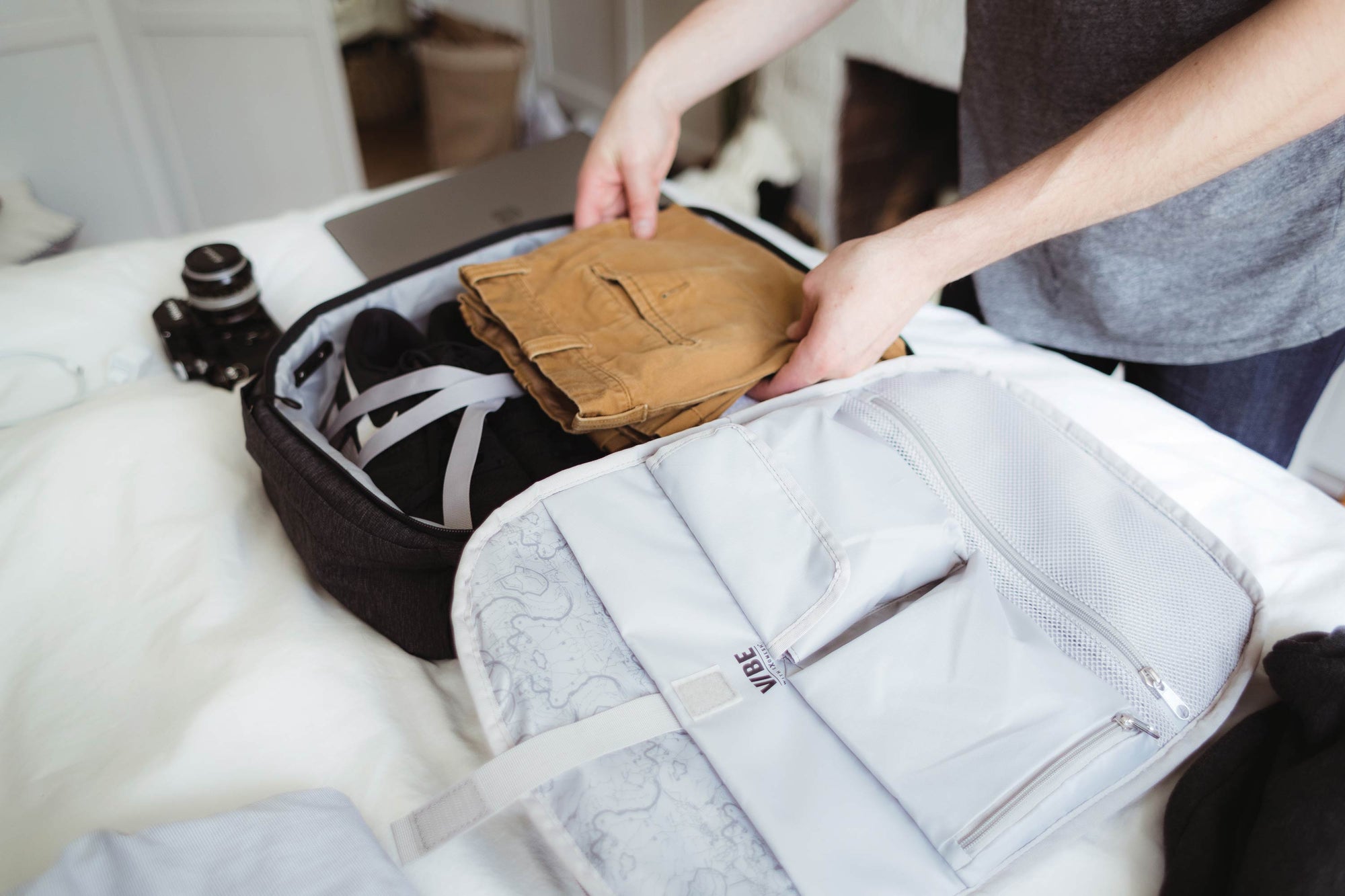To pack a backpack for air travel, prioritize essentials and follow TSA guidelines. Choose versatile clothing and use compression bags to maximize space.
Packing a backpack for air travel doesn’t have to be stressful. Think about what you need on a daily basis and what the airline permits. Align your packing strategy with the duration of your trip, the weather at your destination, and the activities you plan to engage in.
Always check the latest Transportation Security Administration (TSA) regulations to ensure your items are permissible and pack them for easy access during security checks. Roll your clothes to save space and prevent wrinkles, and consider multi-functional garments that can be dressed up or down. Keeping electronics and liquids within reach helps speed up the security process. Remember, smart packing is not just about saving space; it’s about making your travel smoother and adhering to airline requirements.

Credit: www.wikihow.com
Packing Essentials: Starting Right
Packing a backpack for air travel is more than tossing in clothes. It requires thought and a plan. Start with the essentials. A well-packed backpack ensures a stress-free journey. Whether you’re a seasoned traveler or a novice, every trip begins with packing right.
Choosing The Right Backpack
Backpack selection is crucial for comfort and convenience. Consider the type of travel and the backpack’s features. Size, material, and compartments make a big difference. Your backpack should be lightweight yet durable and comply with airline carry-on regulations.
- Opt for adjustable straps to distribute weight evenly.
- Choose a backpack with multiple compartments for organization.
- Ensure it fits airline size requirements for carry-on luggage.
Essential Packing Checklist
Creating an essential packing checklist avoids leaving important items behind. Use the following list to ensure you’ve included everything necessary for a smooth trip. Check items off as you pack.
| Category | Items |
|---|---|
| Documents |
|
| Tech |
|
| Personal Items |
|
| Clothing |
|
Remember, roll clothing to save space. Place heavier items at the bottom. Keep documents and liquids accessible for security checks.

Credit: blog.tortugabackpacks.com
Maximizing Space
Packing a backpack for air travel can feel like a puzzle. Each item must fit perfectly to make the best use of space. Follow these tips to help squeeze in everything you need without overstuffing your bag or leaving essentials behind.
Roll Or Fold: Best Practices For Clothes
To start off, think about your clothes. They take up most of the space. The secret is in how you arrange them.
- Roll softer garments like cotton shirts, jeans, and knitwear. They’ll form compact tubes and prevent creasing.
- Fold stiffer fabrics such as blazers and dress pants. This maintains their shape.
Try the Ranger Roll technique for a military-style pack. It saves space and keeps clothes wrinkle-free.
Utilizing Compartments Strategically
Your backpack’s design can help you pack smart. Use every pocket and slot to your advantage.
| Compartment | Items to Pack |
|---|---|
| Main compartment | Heavier items and rolled clothes |
| Top pocket | Easy access items like headphones |
| Side pockets | Water bottles and umbrellas |
| Front pouch | Travel documents and snacks |
Remember to keep electronics and liquids near the top. This makes removing them at security checkpoints a breeze.
Staying Within Regulations
Packing a backpack for air travel requires attention to detail. Knowing the regulations helps you glide through security. Stick to the rules to avoid hiccups during your flight preparation.
Understanding Tsa Liquid Rules
When prepping your carry-on, consider the TSA’s 3-1-1 liquid rule. This is key to a smooth checkpoint experience. All liquids must be in 3.4-ounce (100 milliliters) containers or smaller. They should fit into one quart-sized, resealable bag. Only one such bag is allowed per passenger. Be sure to place this bag in an easily accessible part of your backpack for screening.
Here are the TSA liquid guidelines in a table for quick reference:
| Liquid per container | Bag size | Quantity per passenger |
|---|---|---|
| 3.4 ounces (100 milliliters) | 1 quart-sized | 1 bag |
Exceptions to these rules include medications and infant or child nourishments. For these, inform the TSA officer before screening begins.
Prohibited Items To Avoid
Some items are a strict no for your travel backpack. Save time and frustration by leaving these out. Common prohibitions include sharp objects, firearms, and flammable items. Check the complete list on the TSA website before packing.
- Sharp objects like knives and scissors should go in checked baggage.
- Firearms must be declared and packed properly in checked baggage.
- Leave flammable liquids like fuels at home.
In summary, staying within regulations means understanding and adhering to TSA rules. This includes managing liquids correctly and avoiding prohibited items. Thorough preparation ensures stress-free boarding and a pleasant journey.
Securing Valuables And Gadgets
Packing for air travel? Remember to keep your valuables and gadgets safe and secure. Airlines see thousands of bags every day. Your bag should stand out for its organization, not because valuables spill out at security. Get ready to make your next trip seamless. Check items swift and secure with these tips.
Packing Electronics For Airport Security
Electronics need special care at airports. You must remove them for security checks. Here’s the right way to do it:
- Use separate pouches or compartments for different devices. This prevents scratches and makes them easy to find.
- Laptops go in an easy-to-reach section of your backpack. Avoid digging at the checkpoint.
- Keep cords tidy with elastic bands or cord organizers. Avoid tangled messes.
- Place small electronics, like phones and tablets, in padded sleeves. This adds an extra layer of protection.
Security will breeze through your electronics with these packing strategies.
Protecting Jewelry And Documents
Jewelry and important documents need extra security in your backpack. Keep them away from prying eyes and potential mishaps.
- Use a jewelry roll or organizer. It keeps pieces separated and prevents damage.
- Slip documents into a waterproof folder or holder. It’s vital for passports and IDs.
- For extra safety, place this folder in an inner pocket or compartment, preferably one that zips.
- Consider a travel wallet for quick access to boarding passes and currency.
Pack smart and your valuables will stay snug and secure during your airport adventure.
Preparing For The Destination
Travel sparks excitement and anticipation. Packing your backpack for air travel requires a strategic approach. Tailor your packing list to your destination. This section delves into adapting to the climate and respecting cultural norms.
Adapting To The Climate: Weather-appropriate Gear
Research your destination’s climate before you travel. Knowing the weather helps you pack the right gear. Pack layers to handle temperature changes. Bring waterproof clothing for rain-prone areas. Include lightweight, breathable fabrics for hot climates. Below is a checklist for weather-appropriate gear:
- Rain jacket: Stay dry during rainy seasons.
- Sun hat: Protect your face in sunny destinations.
- Thermal wear: Keep warm in cold climates.
- Sunglasses: Shield your eyes from harsh sunlight.
- Travel umbrella: Handy for unexpected showers.
Cultural Considerations: Adhering To Local Customs
Respecting local customs is crucial. Research dress codes and traditions. Dress modestly in conservative countries. Ensure comfort and respect in your attire. Use the table below to understand common cultural considerations:
| Custom | Description | Examples |
|---|---|---|
| Dress code | Appropriate attire based on local norms | Long pants in religious sites, no shorts |
| Greetings | Standard ways to greet locals | Bow in Japan, handshake in Brazil |
| Public Behavior | Accepted conduct in public spaces | Quieter voices in Europe, no public display of affection in the Middle East |
Pack considering these cultural guidelines. Bring attire that suits different situations—casual outings to formal events. Ensure you have the right clothes to blend in and respect the community.

Credit: pacsafe.com
Final Checks And Tips
Before you zip up and head out to the airport, a final run-through is a must. Ensuring everything is in order can save time and stress. From airline rules to last-minute hacks, these tips will pave the way for a smooth journey.
Reviewing Airline-specific Rules
Each airline has its own set of guidelines for luggage. This includes dimensions, weight limits, and restricted items. Always check your airline’s website for the most current information. A quick review avoids unnecessary surprises at the check-in counter.
- Dimensions: Confirm your backpack fits the airline’s carry-on size chart.
- Weight limits: Use a home scale to ensure it’s within the allowed weight.
- Restricted items: Check for items not permitted in carry-ons or checked bags.
Last-minute Packing Hacks
Smart last-minute strategies can make the difference between a good and a great travel experience. Use these hacks to pack like a pro:
| Hack | Benefit |
|---|---|
| Rolling Clothes | Saves space and prevents wrinkles. |
| Stuff Shoes | Utilizes empty shoe space for small items like socks. |
| Electronics in Ziplock | Keeps cords organized and water-resistant. |
| Liquid Containers | Avoids spills and follows TSA liquid rules. |
Keep travel documents accessible: Place passports and tickets in an easy-to-reach spot.- Snacks: Pack some in case of delays or hunger pangs.
- Dress Appropriately: Layer clothes to adapt to changing cabin temperatures.
Don’t forget your headphones or a book for in-flight entertainment. Double-check all essentials before leaving. Your attention to detail ensures a tranquil start to any adventure!
Frequently Asked Questions Of How To Pack A Backpack For Air Travel
What Items Are Not Allowed In A Carry-on?
Many airlines prohibit items like flammable liquids, sharp objects, and large tools in carry-on luggage. It’s essential to check with your airline for their specific restrictions to avoid any issues during security checks.
How To Maximize Space In Your Backpack?
Rolling clothes instead of folding can save space. Utilize compartments for small items. Wear your bulkiest items on the plane. Packing cubes can keep things organized and compressed.
Is A Backpack Counted As A Personal Item?
Most airlines allow a backpack as a personal item if it fits under the seat in front. However, size limits vary between airlines, so verify your airline’s size requirements beforehand.
Tips For Quick Airport Security With A Backpack?
Pack liquids easily accessible for screening. Electronics should be in an easily reachable spot. Using TSA-approved locks helps. Pack smart to avoid unpacking everything at security.
Conclusion
Packing your backpack for air travel needn’t be daunting. With smart choices and strategic planning, efficiency meets ease. Ensure all essentials are within reach. Remember, a well-packed bag makes for a smoother journey. Embrace your next adventure with confidence, knowing you’re fully prepared to take on the skies.
